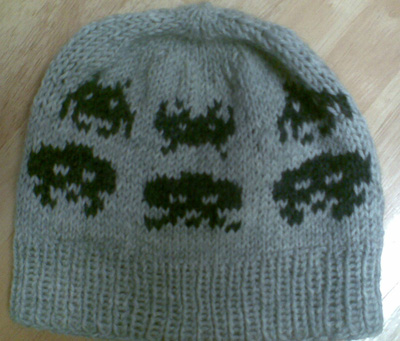Bacterium
My attempt at simulating bacterial growth.
My attempt at simulating bacterial growth.
Considering the climate change hasn’t eliminated winter yet, here’s something to keep your head warm. As a bonus, it won’t deduct from your carefully planned geek look.

The pattern repeats three times around the hat (the hat is 96 stitches around which fits nicely to my adult-sized head). You can use more colors but this results in more threads running inside the hat (and probably is a bit harder to knit), maybe you could use this to your advantage and make the hat warmer.

Note that the above pattern is 28 stitches wide. If your hat isn’t e.g. 28*3=84 stitches wide, you have to pad the pattern with empty stitches. Add the padding stitches at the green lines, in my case there are two and two padding stitches added (i.e. there are four empty stitches between the bottom sprite) to make the pattern 32 stitches wide making the pattern fit exactly three times on the hat. Also, keep in mind the hat starts to get narrower after the pattern ends, so you can’t use the same pattern all the way to the top. In this case only two rows of sprites could be fit on the hat (I wanted a hat that isn’t floppy on the top).
Wikipedia has a pretty comprehensive article on knitting (take a look at the instructional links) but you’ll probably get the same information in a much nicer form if you ask your mom or grandmother. In any case, knitting is not hard. You just have to have some finger dexterity which most geeks have, because geeks type fast.
Most websites feature the possibility to rate articles, files, videos and other content. It’s a good way to keep popular content the most visible. If the ratings are to be used seriously, we need accurate data. Most rating systems do not necessarily provide accurate data.
The biggest reason why rating content doesn’t work as well as it could is the fact humans use the system. Humans are very noisy when it comes to input. While the law of large numbers eventually ensures consensus, choosing a good rating system could make rating stable much faster.

Probably the most common way to rate content is to give it a score, usually between one and five. Some sites use a larger scale, notably IMDB, which scores movies between one and ten points. Now, here’s the big revelation: this is not a very good way to do this.
The more options you have, the harder it is to choose accurately. IMDB probably has an user base of hundreds of thousands (most movies have tens of thousands of voters), which means they could simply have two ratings: “I liked this movie” and “I didn’t like this movie”. Maybe they could throw in “I didn’t like this but I don’t hate it either”, too. Considering the huge amount of votes, they still would get an average score that provided enough accuracy for their charts and whatnot.
Another downside in such a system is the fact people give biased scores. The reasons might vary, my personal excuse is that school grades in Finland go traditionally from four to ten, roughly representing a score of 40 % to 100 % respectively. This means, I rarely vote outside the familiar scale, unless a movie has to be punished and given the lowest rating possible. Which is another example of the noisy input people provide.
Pros: Easy to get accurate data from small user base
Cons: Very noisy, hard to decide between similar options

A slightly more modern way to rate things is ironically a very old method: thumbing things up or down, much like a Roman emperor. As stated above, the limited scale still provides accurate ratings thanks to the law of large numbers. Giving the user two options removes the statistical noise (excluding accidental votes), it is easier to extract the information by asking simply “Did you like this or not?”.
However, giving the user less options limits his or her ability to rank items on their personal lists and favorites, if that is needed. This could be solved with additional questions such as “Did you like X more than Y?”, or simply allowing the user to order items from best to worst in a list. In addition, an ordered list based approach would obviously give more perspective for the user if he or she wants to provide accurate input, having to constantly think of an item really is better than the item below it.
Pros: Easy to vote, less noise
Cons: Needs a bigger data set to provide accurate data
Obviously, all the above is to taken seriously only if you really want to either get better input or if you want to avoid a bit of work: a fancy system doesn’t necessarily provide that much and could only be confusing to the users. My personal choice would be a minimalistic approach, thumbing up or down, that is. Any comments?



(They’re images so copycopy)